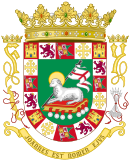
Back حركة الاستقلال في بورتوريكو Arabic Movimiento independentista de Puerto Rico Spanish Movimento pela independência de Porto Rico Portuguese
 |
|---|
Throughout the history of Puerto Rico, its inhabitants have initiated several movements to gain independence for the island, first from the Spanish Empire between 1493 and 1898 and since then from the United States. Today, the movement is most commonly represented by the flag of the Grito de Lares (Cry of Lares) revolt of 1868.
A spectrum of pro-autonomy, pro-nationalism, and pro-independence sentiments and political parties exist on the island. Since the beginning of the 19th century, organizations advocating independence in Puerto Rico have attempted both peaceful political means as well as violent revolutionary actions to achieve its objectives. The declaration of independence of Puerto Rico occurred on September 23, 1868 during the Grito de Lares (Cry of Lares) revolt against Spanish rule. The revolting members and followers of the Revolutionary Committee of Puerto Rico proclaimed the flag of the revolt as the national flag of an independent “Republic of Puerto Rico”, making it the first flag of Puerto Rico. However, the rebels replaced the flag with a new revolutionary flag, the current flag of Puerto Rico, in 1895.
Since the second half of the 20th century, the independence movement has trailed significantly behind the pro-Commonwealth and pro-statehood movements at the ballots. In a status referendum in 2012, 5.5% voted for independence while Statehood obtained 61.1% of the votes cast.[1][2] Independence also received the least support, less than 4.5% of the vote, in the status referendums in 1967, 1993 and 1998.
A fourth referendum was held in 2012, with 54% voting to change Puerto Rico's status but the federal government took no action to do so. The fifth plebiscite was held on June 11, 2017. With a voter turnout of 23%, it had the lowest turnout of any status referendum held in Puerto Rico. The independence option only received 1.52% of the vote in the referendum.
In the 2020 Puerto Rican general election, the Puerto Rican Independence Party achieved 13.6% of the vote, a significant increase in support from the 2016 Puerto Rican general election when it received only 2.1% of votes.[3][4]
- ^ "CEE Event - CONDICIÓN POLÍTICA TERRITORIAL ACTUAL - Resumen" (in Spanish). Comisión Estatal de Elecciones de Puerto Rico. 2012-11-08. Archived from the original on 2012-11-09. Retrieved 2012-11-08.
- ^ "CEE Event - OPCIONES NO TERRITORIALES - Resumen" (in Spanish). Comisión Estatal de Elecciones de Puerto Rico. 2012-11-08. Archived from the original on 2012-11-09. Retrieved 2012-11-08.
- ^ "Is Statehood Next for Puerto Rico? It's Complicated". Medium. 2021-04-08. Archived from the original on 2021-04-10. Retrieved 2021-04-11.
- ^ ""A Tremendous Jump for Progressive Forces": Puerto Rico Election Signals End of Two-Party Dominance". Democracy Now. 2020-11-20. Archived from the original on 2021-04-14. Retrieved 2021-04-11.
© MMXXIII Rich X Search. We shall prevail. All rights reserved. Rich X Search
